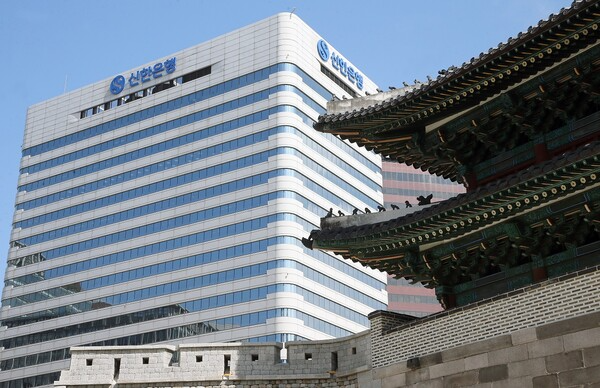
Shinhan Bank's CI / Image courtesy of Shinhan Bank
According to the “H1 2024 Factbook” released by Shinhan Financial Group(CEO Okdong Jin) on the 8th, which contains management indicators of its affiliates, the share of low-cost deposits in total deposits of Shinhan Bank was 37.7% as of June this year, down 9.7 percentage points (p) from June 2022 (47.4%). In terms of value, the outflow was around KRW 20 trillion, down from KRW 152.2 trillion to KRW 130.5 trillion. This is a decrease of 2.2 %p from the previous quarter (39.9%).
The outflow from low-cost deposits was replenished by time deposits. Over the past two years, Shinhan's share of time deposits has surged from 38.8% to 49.4%, meaning that term deposits now account for half of Shinhan's deposits.
Low-cost deposits, such as occasional deposit accounts with interest rates in the 0% range, are considered key operating assets of banks. To use an analogy from the restaurant industry, it's like using the ingredients needed for cooking for "free." On the other hand, time deposits have the advantage of allowing you to save money for a long period of time, but the disadvantage is the high interest rate. Shinhan Bank's 'Sol convenient Time Deposit' has an interest rate of 2.95 to 3.40% per annum, depending on the subscription period.
As a result, it has become more difficult to raise the net interest margin (NIM), a bank's profit indicator. Shinhan Financial Group interpreted the possibility that its customers will end its long-running high-interest rate trend, including the U.S. Federal Reserve's big cut (a 0.5 percentage point cut in benchmark interest rate) last month.
As the needs (demand) of individual and corporate customers change depending on the interest rate situation, there seems to be a recent trend toward deposits with higher interest rates in preparation for a period of falling interest rates rather than low-cost deposits,” said a Shinhan Bank official.

View of Shinhan Bank headquarters./Photo=Shinhan Bank
When interest rates fall, lending rates also come under downward pressure. In this case, an outflow of low-cost deposits and an increase in time deposits will act as upward pressure on the bank's funding rate. This is the case with Shinhan Bank. KB Kookmin Bank, on the other hand, increased its demand deposits, which are low-cost deposits, by 4.5% from KRW 146.5 trillion at the end of 2023 to KRW 153.1 trillion in the first half of this year.
The program is a win-win project that converts 'personal credit loans with a principal amount of KRW 50 million or less and a DSR of 70% or less' held by middle credit income salaried customers of Shinhan Savings Bank into new products exclusively for exchange at Shinhan Bank.
It is analyzed that Shinhan Bank will benefit from the transfer of mid-credit customers with less risk of default and earn higher interest rates than the bank's high-credit prime customers. Shinhan Savings Bank is also facing the need to manage its assets through asset reduction as the proportion of non-performing and cautious loans continues to rise. Shinhan has a lot of room to maneuver as its coverage ratio for bad loans reached 1375% as of June this year.
It is also likely to increase its loan-to-deposit ratio. Shinhan Bank's loan-to-deposit ratio was 96.5% as of June this year, which is slightly lower than KB Kookmin Bank's 98.3%.



























![[ECM] ‘유증 역풍’ 안병철 한화에어로 사장, 미흡한 ‘승계 의혹’ 해명](https://cfnimage.commutil.kr/phpwas/restmb_setimgmake.php?pp=006&w=69&h=45&m=5&simg=2025041010315104302a837df64942115218260.jpg&nmt=18)

![SSG닷컴, 그로서리로 ‘수익성’ 배송…“이마트 DNA 이식” [신선식품 현황점검③]](https://cfnimage.commutil.kr/phpwas/restmb_setimgmake.php?pp=006&w=69&h=45&m=5&simg=2023070717131708353b5b890e35c21823832217.jpg&nmt=18)

![[DCM] '절반 이상이 금융사’… 하이트진로 '온탕', 동화기업 '냉탕' [3월 회사채 리뷰(II)]](https://cfnimage.commutil.kr/phpwas/restmb_setimgmake.php?pp=006&w=69&h=45&m=5&simg=2025041018063209442141825007d12411124362.jpg&nmt=18)

















![[카드뉴스] KT&G ‘Global Jr. Committee’, 조직문화 혁신 방안 제언](https://cfnimage.commutil.kr/phpwas/restmb_setimgmake.php?pp=006&w=298&h=298&m=1&simg=202503261121571288de68fcbb3512411124362_0.png&nmt=18)


![[카드뉴스] 국립생태원과 함께 환경보호 활동 강화하는 KT&G](https://cfnimage.commutil.kr/phpwas/restmb_setimgmake.php?pp=006&w=298&h=298&m=1&simg=202403221529138957c1c16452b0175114235199_0.png&nmt=18)
![[카드뉴스] 신생아 특례 대출 조건, 한도, 금리, 신청방법 등 총정리...연 1%대, 최대 5억](https://cfnimage.commutil.kr/phpwas/restmb_setimgmake.php?pp=006&w=298&h=298&m=1&simg=20240131105228940de68fcbb35175114235199_0.jpg&nmt=18)
![[신간] 리빌딩 코리아 - 피크 코리아 극복을 위한 생산성 주도 성장 전략](https://cfnimage.commutil.kr/phpwas/restmb_setimgmake.php?pp=006&w=81&h=123&m=5&simg=2025032814555807705f8caa4a5ce12411124362.jpg&nmt=18)
![[신간] 지속 가능 경영, 보고와 검증](https://cfnimage.commutil.kr/phpwas/restmb_setimgmake.php?pp=006&w=81&h=123&m=5&simg=2025011710043006774f8caa4a5ce12411124362.jpg&nmt=18)
![[서평] 추세 매매의 대가들...추세추종 투자전략의 대가 14인 인터뷰](https://cfnimage.commutil.kr/phpwas/restmb_setimgmake.php?pp=006&w=81&h=123&m=5&simg=2023102410444004986c1c16452b0175114235199.jpg&nmt=18)

![[신간] 똑똑한 금융생활...건전한 투자와 건강한 재무설계 지침서](https://cfnimage.commutil.kr/phpwas/restmb_setimgmake.php?pp=006&w=81&h=123&m=5&simg=2025031015443705043c1c16452b012411124362.jpg&nmt=18)

![[카드뉴스] KT&G ‘Global Jr. Committee’, 조직문화 혁신 방안 제언](https://cfnimage.commutil.kr/phpwas/restmb_setimgmake.php?pp=006&w=89&h=45&m=1&simg=202503261121571288de68fcbb3512411124362_0.png&nmt=18)
![[AD] 기아, 혁신적 콤팩트 SUV ‘시로스’ 세계 최초 공개](https://cfnimage.commutil.kr/phpwas/restmb_setimgmake.php?pp=006&w=89&h=45&m=1&simg=2024123113461807771f9c516e42f12411124362.jpg&nmt=18)
![[AD] 아이오닉5 '최고 고도차 주행 전기차' 기네스북 올랐다...압도적 전기차 입증](https://cfnimage.commutil.kr/phpwas/restmb_setimgmake.php?pp=006&w=89&h=45&m=1&simg=2024123113204707739f9c516e42f12411124362.jpg&nmt=18)




